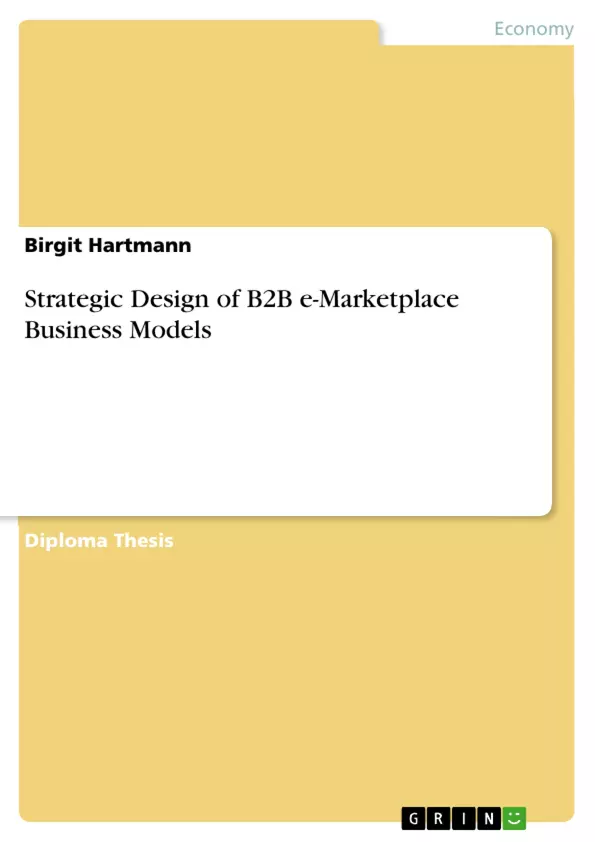B2B Commerce enthusiasm is big – even despite the recent e-marketplace shake-out.
Internet Technology and its technical details involved in creating an e-marketplace is complex, important, and interesting, so that it was easy for many dot-coms to get lost in them. But when it comes to its base, e-business is not about bytes, but still about pure business, as the recent market development has shown.
Obviously, the market will now look more cautiously at the business model content and demands sustainable e-marketplace business model, which has been a basic reason for me to create a practical framework for the design of B2B e-marketplace models.
Breeding ground for my own e-business enthusiasm was certainly my internship at IBM Unternehmensberatung GmbH and further works within the IBM Consulting Group, where I had the chance to gain deeper insight in the creation of e-marketplaces.
During the creation of this report, I have truly been experiencing a lot of cooperative support, interesting discussions, as well as many helpful suggestions, and I would like to acknowledge the contributions of all who participated.
Especially, I wish to express my deep thanks to Martin Koppenborg, Vice President Strategic Accounts at emaro.com, an e-marketplace start-up, Frank Schmidt, Market Analyst at IBM’s e-business services, and to Dr. Alexander Hirschbold, Consultant at Mercer Management Consulting, who each played a critical role in the building process.
Inhaltsverzeichnis (Table of Contents)
- List of Abbreviations
- List of Tables
- List of Figures
- Executive Summary
- Introduction
- Basic Definitions of the New e-conomy
- 10 Strategic Design Considerations for the Creation of a Business Model
- Market and Stakeholder Analysis
- Market Environment
- Key Players
- e-Marketplace Models
- The eMP Cube Model
- e-Marketplace Development
- The different Roles of an e-Marketplace
- Comment
- Value Proposition
- The Buyer
- The Supplier
- The Exchange/ The Investor
- Key Parameters for an e-Marketplace and Value-Added Services
- Information
- Content Management
- Supplier Sourcing
- Commerce Facilitation
- Transaction Management
- Fulfillment
- Settlement
- Infrastructure & Integration
- Collaboration
- Value-Added Services
- e-Marketplace Functional Architecture Model
- Platform Layer
- Application Layer
- Customization Layer
- Pricing Mechanisms
- Revenue Model
- The Different Revenue Streams
- Comment on Revenue Model
- Equity Structure
- eMP Strategic Roadmap
- Business Plan
- Market and Stakeholder Analysis
- Challenges in the B2B e-conomy
- Industry-Specific Requirements for e-Marketplaces
- Attractive Industry Attributes for an Exchange
- The "Multiple Vertical" Strategy
- Industry-Specific Requirements for e-Marketplaces
- Dealing With the Nature of Industry Opportunities: NTE (Case Study)
- The "e2open.com" Business Model Design A Reconstruction based on the 10 Strategic Design Considerations
- Key Success Factors of Winning Business Models
- Business Model Checklist
- Conclusion and Outlook
Zielsetzung und Themenschwerpunkte (Objectives and Key Themes)
This report provides a framework for the design of business models for B2B e-marketplaces. It examines the challenges and opportunities of the B2B e-conomy, highlighting key considerations for successful e-marketplace implementation.- Strategic Design Considerations for B2B e-Marketplace Business Models
- Value Proposition for Buyers, Suppliers, and Exchanges
- Revenue Models and Pricing Mechanisms
- Challenges in the B2B e-conomy
- Industry-Specific Requirements for e-Marketplaces
Zusammenfassung der Kapitel (Chapter Summaries)
- The introduction establishes the context for the report, emphasizing the importance of sustainable business models in the B2B e-commerce environment.
- Chapter 2 defines key concepts related to the new e-conomy, setting the foundation for subsequent discussions on e-marketplace design.
- Chapter 3 outlines 10 strategic design considerations for creating a successful B2B e-marketplace business model. These considerations encompass market analysis, e-marketplace models, value proposition, key parameters, functional architecture, pricing mechanisms, revenue models, equity structure, strategic roadmap, and business plan.
- Chapter 4 explores challenges faced by businesses in the B2B e-conomy, providing insights into potential obstacles to e-marketplace implementation.
- Chapter 5 delves into industry-specific requirements for e-marketplaces, examining how different industry characteristics and opportunities influence e-marketplace design and implementation.
- Chapter 6 presents the "e2open.com" business model as a case study, showcasing the application of the 10 strategic design considerations in a real-world scenario.
- Chapter 7 identifies key success factors for winning business models in the B2B e-commerce landscape.
- Chapter 8 offers a business model checklist as a practical tool for evaluating and improving B2B e-marketplace designs.
Schlüsselwörter (Keywords)
This report examines the key themes of B2B e-marketplace design, strategic considerations, value proposition, revenue models, pricing mechanisms, industry-specific requirements, and the e2open.com case study. The analysis highlights challenges and opportunities in the B2B e-conomy, ultimately aiming to provide a framework for creating sustainable and successful e-marketplace business models.- Quote paper
- Birgit Hartmann (Author), 2001, Strategic Design of B2B e-Marketplace Business Models, Munich, GRIN Verlag, https://www.grin.com/document/185580



